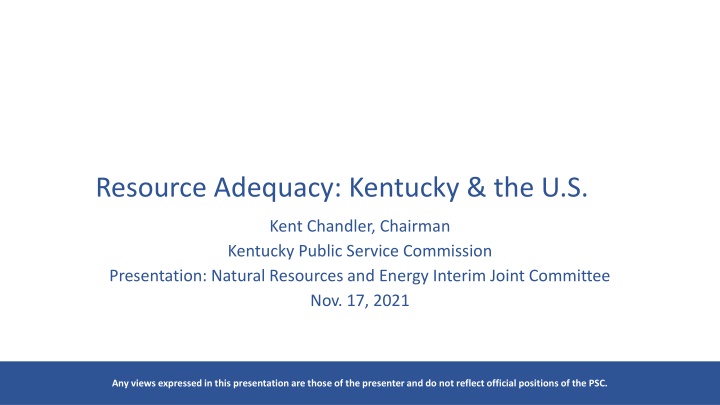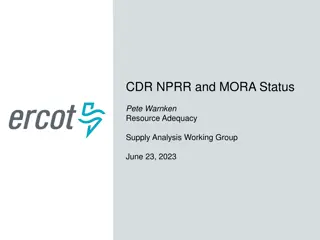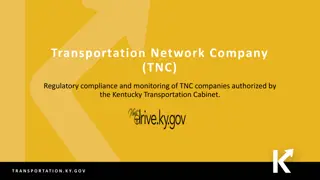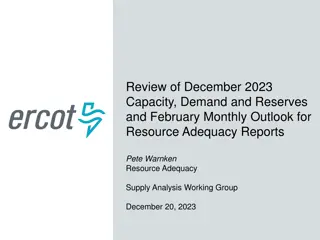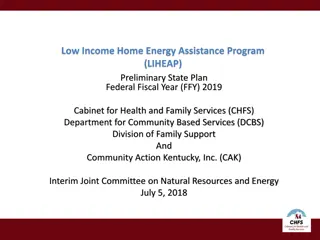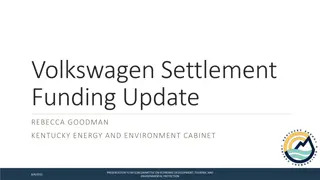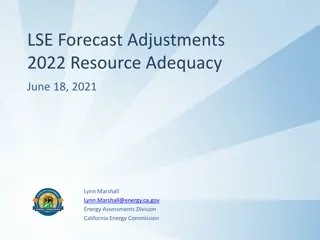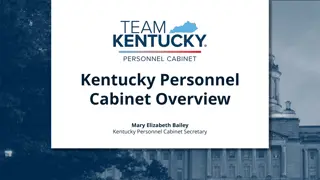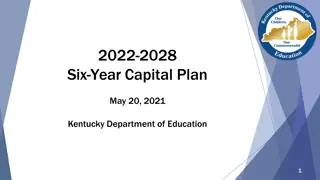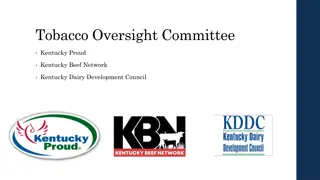Resource Adequacy in Kentucky and the U.S.: Regulatory Insights
Presentation by Kent Chandler, Chairman of the Kentucky Public Service Commission, highlighting the significance of resource adequacy in ensuring reliable electricity supply. The role of regulatory agencies like PSC in reviewing utility investments, integrated resource planning, and the distinction between regulated and deregulated states is discussed. Understanding the principles of utility regulation, the importance of reliability, and the stakeholders responsible for maintaining resource adequacy are key takeaways from the presentation.
Download Presentation

Please find below an Image/Link to download the presentation.
The content on the website is provided AS IS for your information and personal use only. It may not be sold, licensed, or shared on other websites without obtaining consent from the author.If you encounter any issues during the download, it is possible that the publisher has removed the file from their server.
You are allowed to download the files provided on this website for personal or commercial use, subject to the condition that they are used lawfully. All files are the property of their respective owners.
The content on the website is provided AS IS for your information and personal use only. It may not be sold, licensed, or shared on other websites without obtaining consent from the author.
E N D
Presentation Transcript
Resource Adequacy: Kentucky & the U.S. Kent Chandler, Chairman Kentucky Public Service Commission Presentation: Natural Resources and Energy Interim Joint Committee Nov. 17, 2021 Any views expressed in this presentation are those of the presenter and do not reflect official positions of the PSC.
Public Service Commission Independent Regulatory Agency Three-member Commission Quasi-judicial function Regulates rates and service provided by jurisdictional utilities: 1,100 jurisdictional utilities Water and sewer utilities (small systems comprise the bulk of regulated utilities) Natural gas distribution systems and intrastate pipelines Electric utilities (investor-owned and jurisdictional cooperatives) Telecommunications (small number) Does not regulate municipal utilities except for gas pipeline safety. Does not regulate cooperatives served by TVA. 2
ReliabilityService and Rates Since 1934, the primary statutory directive of utility regulation in Kentucky revolves around: Rates Fair, just and reasonable Service Adequate, efficient and reasonable Most everything in retail utility regulation comes back to one or both of these principles. 3
Ensuring Reliability Resource Adequacy: The ability of the electricity system to supply aggregate electric power and energy to meet the requirements of consumers at all times, taking into account scheduled and unscheduled outages of system components. System reliability depends on both resource adequacy and operational reliability to design, plan, and operate the electric grid. (Resource Adequacy Primer for State Regulators, July 2021, NARUC) (North American Electric Reliability Corporation) 4
Who Is Responsible for Resource Adequacy? It depends! Primarily the role of a state, especially in traditionally regulated, vertically integrated states such as Kentucky: PSC reviews and approves utility investments in generation Integrated Resource Plans 15-year forecast filed by jurisdictional utilities every 3 years Not all states are vertically integrated, some are deregulated/retail competition: TX, CA, MD, IL, MI, OH, PA, NJ, DE Also North American Electric Reliability Council; Federal Energy Regulatory Commission; RTOs/ISOs. RTO Regional Transmission Organization Deregulated states depend on wholesale markets, like RTOs, for resource adequacy 5
RTOs/ISOs Four of Kentucky s electric utilities are members of wholesale power markets. MISO: Big Rivers Electric Corporation PJM: East Kentucky Power Cooperative Duke Energy Kentucky Kentucky Power Over at least the past decade PJM and MISO have been assessing operational, planning, and market impacts of adding increasing amounts of wind and solar power. 6
Matters Complicating Resource Adequacy Technological & Economic technological advancements combined with declining costs of some resource options Wind, solar, storage, smart thermostats, distributed resources, demand response, etc. States policies Renewable standards; carbon policies; enhancing resource strengths (e.g., states with wind resources); electricity restructuring; resilience planning Economic development, corporate drivers Federal policies including decades -long FERC policies to increase competitiveness of wholesale electricity markets and reduce barriers to entry via access to markets Other market forces growth of RTOs/ISOs; utility decision-making 7
Resource Adequacy Retail/PSC Regulation Integrated Resource Planning (807 KAR 5:058) prescribes rules for regular reporting and commission review of load forecasts and resource plans of electric utilities to meet future demand with an adequate, reliable supply of power within their service areas. Each utility files triennially includes historical and projected demand, resource, and financial data, and other operating performance and system information. IRPs contain a 15-year planning horizon. IRPs include summary of forecasts of energy and peak demand; economic and demographic assumptions; planned resource acquisitions, new power plants, transmission improvements, etc. Intervenors; Formal Hearing 8
PJM & MISO Resource Adequacy & Reliability Effective load carrying capability (ELCC): Measurement of a generating resource s ability to produce energy when the grid is most likely to experience electricity shortfalls; expressed as a percentage of a resource s capacity. Accurate ELCC calculations = enhanced reliability Diminishing reliability as certain resources are added Capacity Markets ensures long-term grid reliability by procuring the appropriate amount of power supply resources needed to meet predicted energy demand three years in the future. PJM s is much more useful to ensure resource adequacy than MISO s PJM has Capacity Performance requirement that generators must meet commitments to deliver electricity whenever PJM determines they are needed to meet system emergencies (incentives & penalties) Reserve Pricing increases markets prices as scarcity increases, driving reserves 9
PJM & MISO Resource Adequacy & Reliability continued... Futures development forward-looking planning scenarios of the energy landscape that establish different ranges of economic, policy, and technological possibilities (such as load growth, electrification, carbon policy, generator retirements, renewable energy levels, natural gas price, and generation capital cost) over a twenty-year period. Renewable Integration Impact Assessment conducted to understand the impacts of renewable energy growth over the long term. Managing the system under such conditions, particularly beyond the 30% system-wide renewable level is not insurmountable and will require transformational change in planning, markets, and operations. RIIA concludes that renewable penetration of at least 50% can be achieved through additional coordinated action. 10
What changes are necessary to adapt? Greater detail in IRPs include dynamic changes to transmission and distribution system, not just generation; better, more frequent data Greater stratification of reliability contribution- ELCC becoming more and more important Greater emphasis on modeling increased and changing demand; electrification; supply and demand resources; energy efficiency Supply side resources what kind of generation is even available? Contributions to reliability- DERs, renewables, etc. More flexibility required; greater variability with reserve margins Gas-electric coordination Greater interconnection amongst utilities, RTOs and within entire interconnections (Eastern, Western, Texas) 11
Supply Side Resources- what is available? Wind Few places in Kentucky have adequate wind speeds and topography Solar Requires about 6-10 acres per MW, less reliability contribution in winter months Nuclear Currently unlikely, however emerging, advanced technologies could alter viability Coal New units unable to be built, primarily because of NSR requirements Natural Gas Often chosen by generation modeling as least-cost resource, but risks exist around ability to site infrastructure and actual useful life Energy Efficiency/Demand Side Management plenty of cost-effective amounts available, but inability to actually produce electricity Batteries limited duration (4 to 8 hours) and relatively expensive Hybrid Resources Promising, but relatively new Hydrogen Not yet proven to be cost-effective or readily available 12
A Few Key Take-Aways & Considerations Utility planning is more difficult and involved than it has been anytime in the last 100 years Kentucky is a traditional vertically integrated state. While most of the state s jurisdictional utilities participate in wholesale electricity markets, issues of resource adequacy, reliability, planning, etc., are subject to state jurisdiction. The Commission has indicated on multiple occasions it has no interest in our utilities depending on markets for generation capacity for any long (more than a year or two) period of time; will continue to emphasize a preference for steel in the ground Unlike Texas, most of the electric grid east of the Rockies is largely interconnected. We must stay engaged and active on these issues; Waiting is not an option Energy storage game changer? 13
Traditional Electricity Delivery System Mostly one-way system with dispatchable resources. Clear components of generation, transmission, and distribution The Evolving Electric Power Grid As more variable resources and more distributed resources are integrated into the grid, planning and operations are evolving. Sources: EIA (How Electricity is Delivered to Consumers) and DOE (Quadrennial Technology Review) 14
